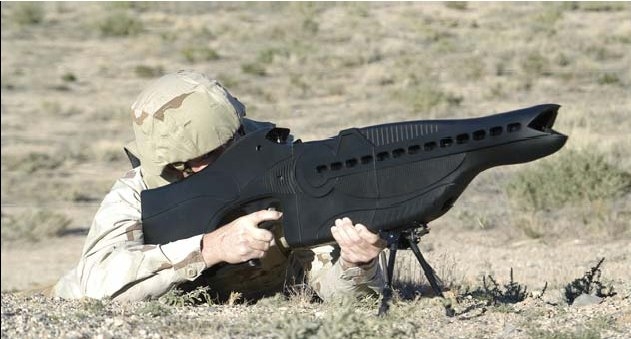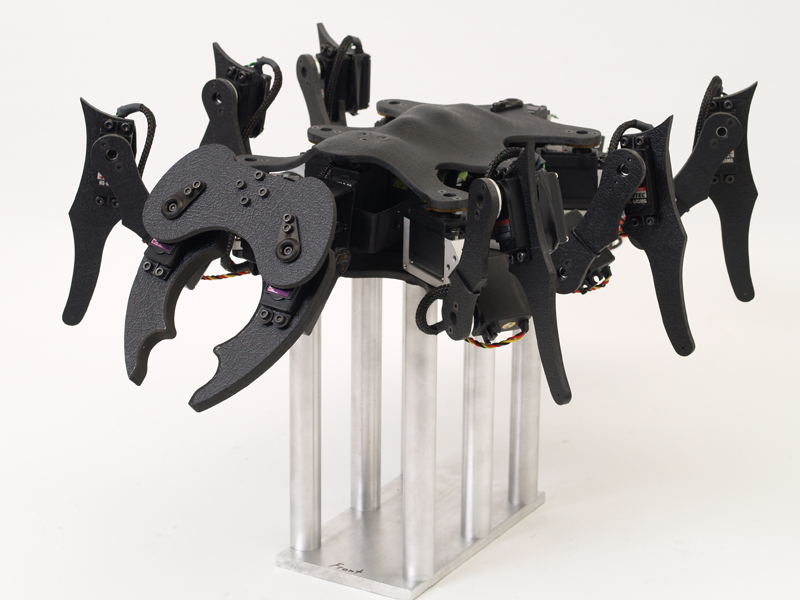Sunday, November 29, 2009
DancePants
Dancepants
Dancepants Kinetic Music Player designed by Lithuanian designers Inesa Malafej and Arunas Sukarevicius. It is a brilliant and simple concept, using kinetic energy to generate the power for MP3 player while you running and dancing. The kinetic module is attached at the pants leg with a connection running along the leg up to a pocket where the MP3 player is connected.
"it is a 100% interactive way to feel the value of energy on your own . During the movement of feet, kinetic energy is collected to play music. The inverse dynamism of "Dancepants" motivates you to move your feet in order to hear your beloved music. And as long as you keep running or dancing you can be sure you won’t run out of battery. "
Dancepants Kinetic Music Player designed by Lithuanian designers Inesa Malafej and Arunas Sukarevicius. It is a brilliant and simple concept, using kinetic energy to generate the power for MP3 player while you running and dancing. The kinetic module is attached at the pants leg with a connection running along the leg up to a pocket where the MP3 player is connected.
"it is a 100% interactive way to feel the value of energy on your own . During the movement of feet, kinetic energy is collected to play music. The inverse dynamism of "Dancepants" motivates you to move your feet in order to hear your beloved music. And as long as you keep running or dancing you can be sure you won’t run out of battery. "
Tuesday, November 17, 2009
Leonid meteor showers to light up night sky on Tuesday and Wednesday
Leonid meteor showers to light up night sky on Tuesday and Wednesday:
For people in Pakistan: the websites say the meteors will be seen at 21:40 (9:40 PM) GMT on 17th November which is 2:40 AM of 18th November in Pakistan.. we have to add 5 hours to the GMT times to get the Pakistani time as pakistan lies in the time zone of GMT +5...
http://timesofindia.indiatimes.com/city/chandigarh/Leonid-meteor-showers-to-light-up-night-sky-on-Monday/articleshow/5233692.cms
The night sky would light up for the next couple of days with Leonid meteor shower would be able to witness the spectacle of about 15-20 shooting stars every hour during this time.
C B Devgun of a Delhi-based NGO, SPACE, said: “A shower of shooting stars is something that happens only a few times. Leonids is one of these and the most prominent one. As a result, the rest of the stars appear as circular arcs.”
“Leonids are a prolific meteor shower associated with comet Tempel-Tuttle. The shower is visible every year around November 17 when the Earth moves through the Leonid meteor stream that comprises solid particles known as meteoroids, ejected by the comet as it passes by the Sun. Though the entire meteor streaks are parallel, they appear to originate from a single point in the sky and as a result Leonids get their name from the location of their radiant in the constellation Leo.”
He added: “Most visible Leonids are between 1 mm and 1 cm in diameter. For example, a Leonid meteor barely visible with the naked eye in a dark sky is caused by a meteoroid of 0.5 mm in diameter and weighs only 0.00006 gram. Just before they enter the Earth’s atmosphere, Leonid meteoroids travel at 71 km per second, or 213 times the speed of sound.”
The showers would be visible from November 14 to 21. “This year, the peak will be on the night of November 17 night and 18 morning around 3 am IST. It’s a favorable position for Indian observers to behold 100-200 meteors per hour during peak activity between 3-4am. No moon and presence of Mars near the radiant will make it look more spectacular as some of the meteors from Leonids would actually be seen as if are from Mars,”he added.
“A meteor is commonly called a shooting star. These can be seen on any night, but when the number is large, it is called a meteor shower. It lasts for just fraction of a second before they are gone,” Devgun said.
How to observe the shower? C B Devgun of a Delhi-based NGO said: “Meteor watching is one of the easiest forms of astronomy. Anyone can go out during early morning hours, lie back and wait for the occasional shooting star. Make sure that you have selected an area where light pollution is at its minimum. Plan to start your watch around 1am. By then, LEO constellation (radiant of Leonids) will be fairly high above the horizon. The hour before dawn should be best of all.”
He added: “The simplest thing to do is just count the number of ‘shower’ and ‘non-shower’ meteors that you see. Shower meteors will seem to come from the Leo constellation. Trace the path of a meteor backwards across the sky. If the line comes near the radiant, then you have observed a shower meteor. If the line goes elsewhere, then you have observed a non-shower meteor. Keep your field of vision filled with sky.”
For people in Pakistan: the websites say the meteors will be seen at 21:40 (9:40 PM) GMT on 17th November which is 2:40 AM of 18th November in Pakistan.. we have to add 5 hours to the GMT times to get the Pakistani time as pakistan lies in the time zone of GMT +5...
http://timesofindia.indiatimes.com/city/chandigarh/Leonid-meteor-showers-to-light-up-night-sky-on-Monday/articleshow/5233692.cms
The night sky would light up for the next couple of days with Leonid meteor shower would be able to witness the spectacle of about 15-20 shooting stars every hour during this time.
C B Devgun of a Delhi-based NGO, SPACE, said: “A shower of shooting stars is something that happens only a few times. Leonids is one of these and the most prominent one. As a result, the rest of the stars appear as circular arcs.”
“Leonids are a prolific meteor shower associated with comet Tempel-Tuttle. The shower is visible every year around November 17 when the Earth moves through the Leonid meteor stream that comprises solid particles known as meteoroids, ejected by the comet as it passes by the Sun. Though the entire meteor streaks are parallel, they appear to originate from a single point in the sky and as a result Leonids get their name from the location of their radiant in the constellation Leo.”
He added: “Most visible Leonids are between 1 mm and 1 cm in diameter. For example, a Leonid meteor barely visible with the naked eye in a dark sky is caused by a meteoroid of 0.5 mm in diameter and weighs only 0.00006 gram. Just before they enter the Earth’s atmosphere, Leonid meteoroids travel at 71 km per second, or 213 times the speed of sound.”
The showers would be visible from November 14 to 21. “This year, the peak will be on the night of November 17 night and 18 morning around 3 am IST. It’s a favorable position for Indian observers to behold 100-200 meteors per hour during peak activity between 3-4am. No moon and presence of Mars near the radiant will make it look more spectacular as some of the meteors from Leonids would actually be seen as if are from Mars,”he added.
“A meteor is commonly called a shooting star. These can be seen on any night, but when the number is large, it is called a meteor shower. It lasts for just fraction of a second before they are gone,” Devgun said.
How to observe the shower? C B Devgun of a Delhi-based NGO said: “Meteor watching is one of the easiest forms of astronomy. Anyone can go out during early morning hours, lie back and wait for the occasional shooting star. Make sure that you have selected an area where light pollution is at its minimum. Plan to start your watch around 1am. By then, LEO constellation (radiant of Leonids) will be fairly high above the horizon. The hour before dawn should be best of all.”
He added: “The simplest thing to do is just count the number of ‘shower’ and ‘non-shower’ meteors that you see. Shower meteors will seem to come from the Leo constellation. Trace the path of a meteor backwards across the sky. If the line comes near the radiant, then you have observed a shower meteor. If the line goes elsewhere, then you have observed a non-shower meteor. Keep your field of vision filled with sky.”
Sixth Sense Technology
Sixth Sense Technology
Pranav Mistry: MIT grad student

http://www.ted.com/talks/pranav_mistry_the_thrilling_potential_of_sixthsense_technology.html
http://www.pranavmistry.com/
Why you should listen to him:
Some previous projects from Mistry's work at MIT includes intelligent sticky notes, Quickies, that can be searched and can send reminders; a pen that draws in 3D; and TaPuMa, a tangible public map that can act as Google of physical world. His research interests also include Gestural and Tangible Interaction, Ubiquitous Computing, AI, Machine Vision, Collective Intelligence and Robotics.
Thursday, November 12, 2009
Pomegranate Phone
Pomegranate Phone:
http://www.pomegranatephone.com/
http://www.pomegranatephone.com/
The Pomegranate is a fictional mobile phone, from Nova Scotia releasing in late September 2008. The website boasts a number of comic features (such as a video projector, live voice translator, harmonica, coffee maker, and shaving razor, among many other standard features that current leading mobile phones have), but upon clicking "I've seen enough" or "Release date", an array of information about Nova Scotia and its culture is displayed. The campaign, which included online advertising on sites in New England, is an attempt to attract interest in Nova Scotia and establish it as a desirable place to live and do business.
Pomegranate phone is the latest campaign from Communications Nova Scotia's Come to Life initiative, the place-branding program of the Government of Nova Scotia. Communications Nova Scotia has been criticized by some for spending $300,000 on the ad campaign, though the website received more than 1,100,000 visits from 201 countries/territories since its launch on September 30, 2008, and they are considering it to be very successful.
Tuesday, November 10, 2009
A Personal Power Generator
A Personal Power Generator
Nanoscale sensors are exquisitely sensitive, very frugal with power, and, of course, tiny.. The goal of Zhong Lin Wang, a materials scientist at Georgia Tech, is to bring power to the nano world with minuscule generators that take advantage of piezoelectricity. If he succeeds, biological and chemical nano sensors will be able to power themselves.
 According to NPR, a Cleveland startup called Tremont Electric will make a flashlight-sized device that converts energy from walking into electrical current for recharging the batteries in personal electronics. Springs inside the device bounce up and down, causing a magnet to oscillate and create an electrical current. The device is currently on pre-order and should arrive in time for Christmas.
According to NPR, a Cleveland startup called Tremont Electric will make a flashlight-sized device that converts energy from walking into electrical current for recharging the batteries in personal electronics. Springs inside the device bounce up and down, causing a magnet to oscillate and create an electrical current. The device is currently on pre-order and should arrive in time for Christmas.
Nanoscale sensors are exquisitely sensitive, very frugal with power, and, of course, tiny.. The goal of Zhong Lin Wang, a materials scientist at Georgia Tech, is to bring power to the nano world with minuscule generators that take advantage of piezoelectricity. If he succeeds, biological and chemical nano sensors will be able to power themselves.
 According to NPR, a Cleveland startup called Tremont Electric will make a flashlight-sized device that converts energy from walking into electrical current for recharging the batteries in personal electronics. Springs inside the device bounce up and down, causing a magnet to oscillate and create an electrical current. The device is currently on pre-order and should arrive in time for Christmas.
According to NPR, a Cleveland startup called Tremont Electric will make a flashlight-sized device that converts energy from walking into electrical current for recharging the batteries in personal electronics. Springs inside the device bounce up and down, causing a magnet to oscillate and create an electrical current. The device is currently on pre-order and should arrive in time for Christmas.Mobile electronic devices like the iPhone only require 2.5 watts of power to fully recharge themselves, he [company founder Aaron LeMieux] says. "So, in the end, all we have to do is harvest 2.5 percent of your human walking energy, without you knowing it, and put it in your mobile electronic device."According to the company's website, the device weighs 9 ounces and can produce 4 watts of power to recharge mobile devices at the same rate as a wall outlet. This would be a cool device to have while we wait for nanogenerators to get out of the lab and onto market.
NOKIA hazardous mobile charger exchange program
Nokia hazardous charger exchange program
Nokia is replacing 14 million cellphone chargers which it says could give users an electric shock.
http://chargerexchange.nokia.com/chargerexchange/en/
Nokia has announced an exchange program for a limited number of Nokia-branded chargers manufactured by a third party supplier. We have determined that the plastic covers of the affected chargers could come loose and separate, exposing the charger’s internal components and potentially posing an electric shock hazard if certain internal components are touched while the charger is plugged into a live socket.
While we are not aware of any incidents or injuries related to the affected chargers, as a precautionary measure, we will exchange affected charger models free-of-charge.
The affected chargers are those manufactured by BYD between June 15, 2009 and August 9, 2009 and with the following model types
AC -3U
AC-3E
and those manufactured by BYD between April 13, 2009 and October 25, 2009 and with the following model type
AC-4U
Affected chargers may have been sold with a Nokia device or purchased separately as an accessory.Your charger is not impacted by this action if you purchased it before June 15, 2009 for models AC-3U and AC-3E and before April 13, 2009 for model AC-4U or it is a similar charger model manufactured by any other supplier.
The reliability and quality of our products, is Nokia’s top priority. If you have confirmed that your charger is eligible to be replaced, we advise that you stop using it, and seek a free replacement charger.
An exchange program has been arranged for all markets in which affected chargers have been sold. To minimize inconvenience to our customers, the exchange will take place at the country level.
Submit specific information from the charger label using the menu below to determine if it is within the scope of the exchange program.
The affected chargers are those manufactured by BYD between June 15, 2009 and August 9, 2009 and with the following model types
AC -3U
AC-3E
and those manufactured by BYD between April 13, 2009 and October 25, 2009 and with the following model type
AC-4U



 Model number
Model number  Identification number
Identification number  Your details
Your details  Verification
Charger model number
Verification
Charger model number
-
Nokia is replacing 14 million cellphone chargers which it says could give users an electric shock.
Dear Nokia Customer,
http://chargerexchange.nokia.com/chargerexchange/en/
Nokia has announced an exchange program for a limited number of Nokia-branded chargers manufactured by a third party supplier. We have determined that the plastic covers of the affected chargers could come loose and separate, exposing the charger’s internal components and potentially posing an electric shock hazard if certain internal components are touched while the charger is plugged into a live socket.While we are not aware of any incidents or injuries related to the affected chargers, as a precautionary measure, we will exchange affected charger models free-of-charge.
The affected chargers are those manufactured by BYD between June 15, 2009 and August 9, 2009 and with the following model types
AC -3U
AC-3E
and those manufactured by BYD between April 13, 2009 and October 25, 2009 and with the following model type
AC-4U
Affected chargers may have been sold with a Nokia device or purchased separately as an accessory.Your charger is not impacted by this action if you purchased it before June 15, 2009 for models AC-3U and AC-3E and before April 13, 2009 for model AC-4U or it is a similar charger model manufactured by any other supplier.
The reliability and quality of our products, is Nokia’s top priority. If you have confirmed that your charger is eligible to be replaced, we advise that you stop using it, and seek a free replacement charger.
An exchange program has been arranged for all markets in which affected chargers have been sold. To minimize inconvenience to our customers, the exchange will take place at the country level.
Submit specific information from the charger label using the menu below to determine if it is within the scope of the exchange program.
The affected chargers are those manufactured by BYD between June 15, 2009 and August 9, 2009 and with the following model types
AC -3U
AC-3E
and those manufactured by BYD between April 13, 2009 and October 25, 2009 and with the following model type
AC-4U



 Model number
Model number  Identification number
Identification number  Your details
Your details  Verification
Verification -
Monday, November 9, 2009
Brust Projector Cell Phone
Brust Projector Cell Phone :
Burst is a concept projector phone designed to boost the functionality and mobility of the conventional touch phones. Burst can project images onto any type of flat surface from projectors mounting aside with its specialized software to deform and compress the touch space display. The touch screen performs just like the traditional screens, but the operation takes place on the virtual projection space. Burst can project HD interactive full color touch spaces showing applications and menus, that opens in a lower touch space. The innovative user interface of Burst utilizes sound and motion sensors to capture as well as process user interactions insidethe touch space.
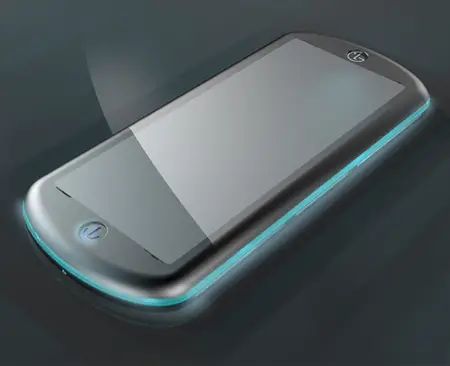
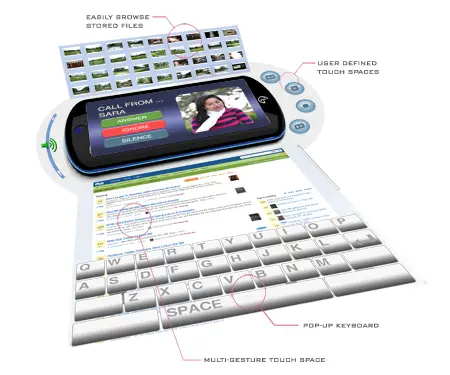
Super functional applications are the key attribute of Burst. It supports revolutionary video conferencing which will help the deaf and hearing impaired aside from offering many other advantages. The innovative technology of combining a mobile device with a protection product has made it as functional and usable as a personal computer. Moreover, it is packed with various category games to make it a nice piece for all range of gamers. Other highlighted features of Burst include HD projected web browsing, document and media editing,video conferencing and online gaming. It can make user to send and receive calls, take pictures and video, download and listen to music and many more.
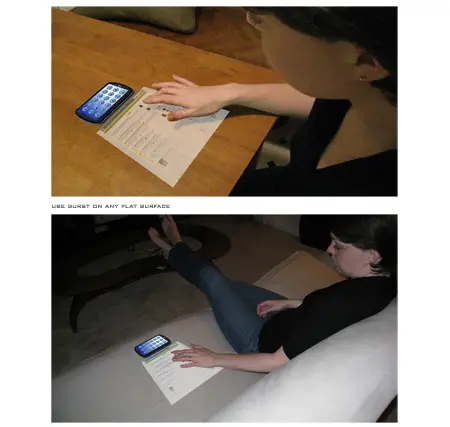
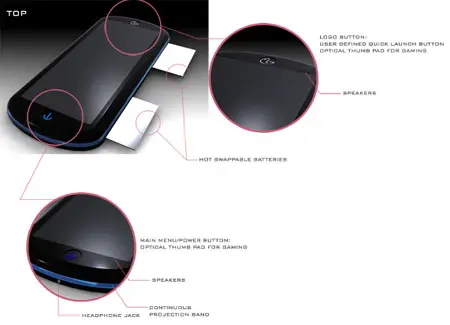
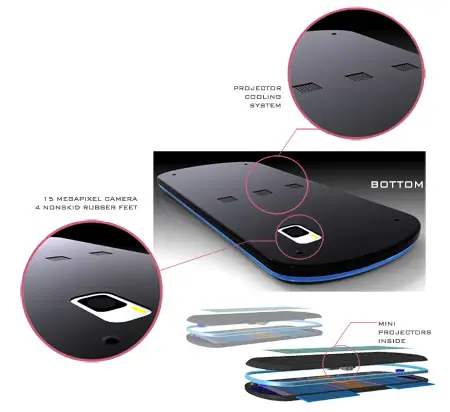
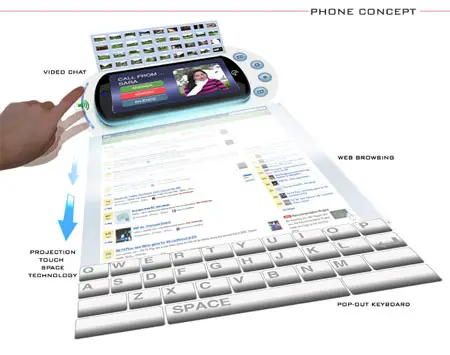
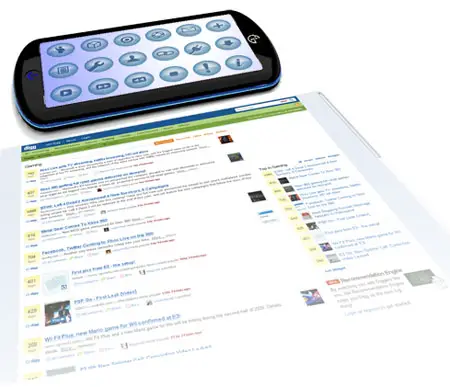
Burst is a concept projector phone designed to boost the functionality and mobility of the conventional touch phones. Burst can project images onto any type of flat surface from projectors mounting aside with its specialized software to deform and compress the touch space display. The touch screen performs just like the traditional screens, but the operation takes place on the virtual projection space. Burst can project HD interactive full color touch spaces showing applications and menus, that opens in a lower touch space. The innovative user interface of Burst utilizes sound and motion sensors to capture as well as process user interactions insidethe touch space.


Super functional applications are the key attribute of Burst. It supports revolutionary video conferencing which will help the deaf and hearing impaired aside from offering many other advantages. The innovative technology of combining a mobile device with a protection product has made it as functional and usable as a personal computer. Moreover, it is packed with various category games to make it a nice piece for all range of gamers. Other highlighted features of Burst include HD projected web browsing, document and media editing,video conferencing and online gaming. It can make user to send and receive calls, take pictures and video, download and listen to music and many more.





D-Roll Laptop
D-roll is a next generation concept laptop design which is way distinctive from usual laptops in both shape and function. The long tube shape of this laptop, which was inspired from the storage tubes that artists are using for storing large drawings, eliminates perception of the traditional book looking laptops. This multifunctional laptop has two working modes. When it is operating in full function mode, the laptop is unfolded completely and all peripherals are turned on. The main display is turned off and a smaller screen, attached with main body is turned on allowing the users to check and send mails when D-roll is under email mode. VC is a helpful add-on for capturing pictures or videos and Locking System can provide certain security to the laptop.
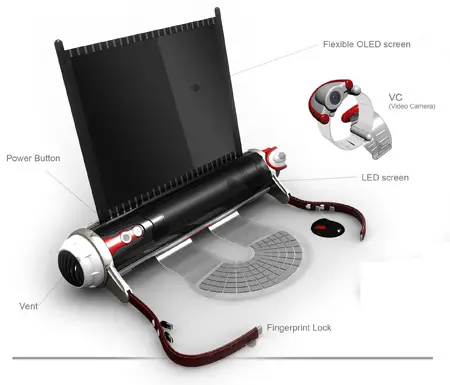
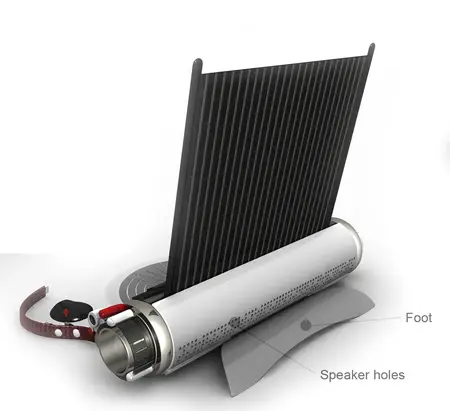
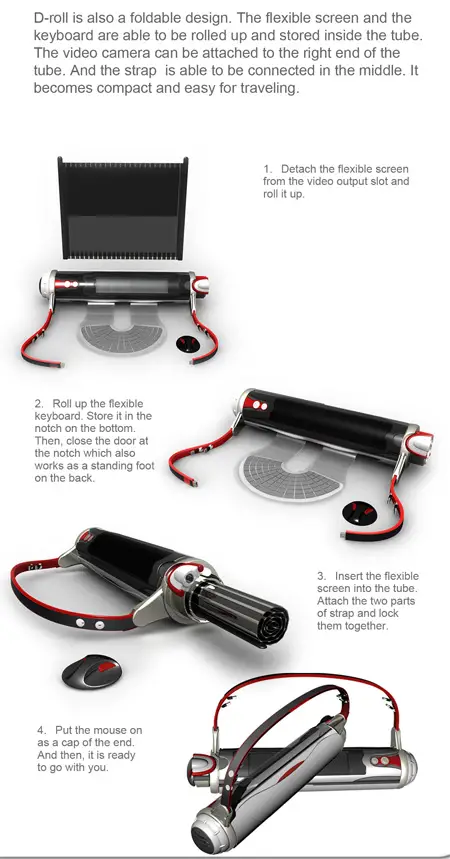
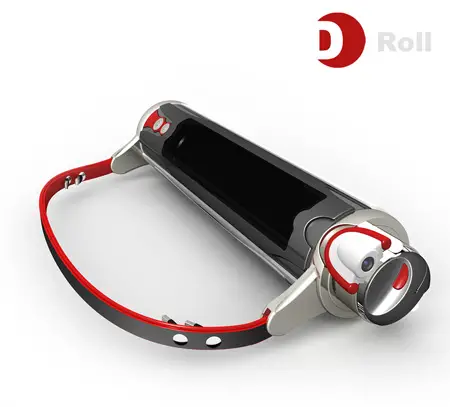
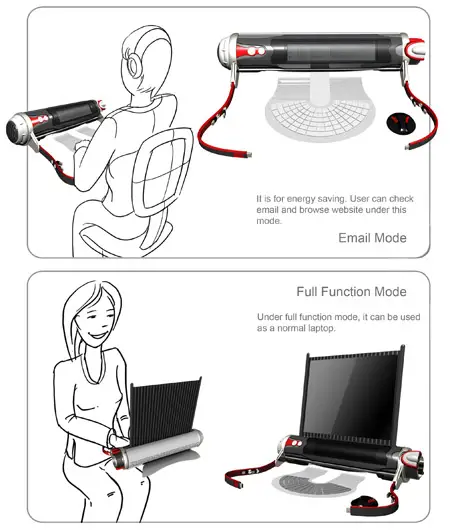
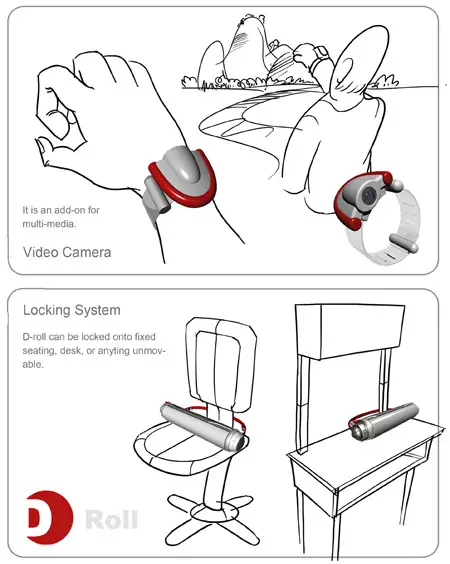
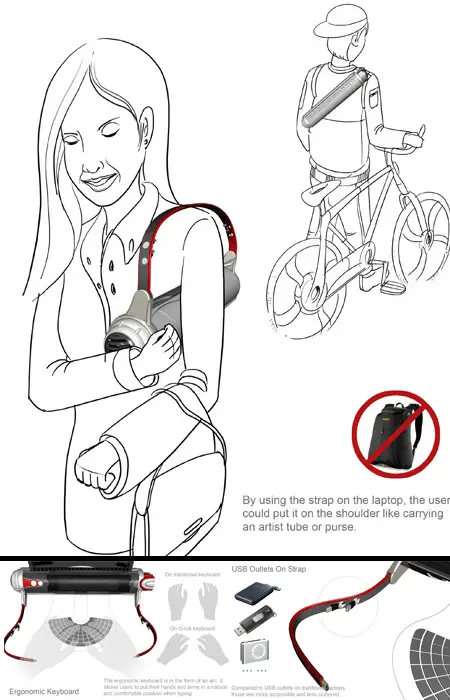
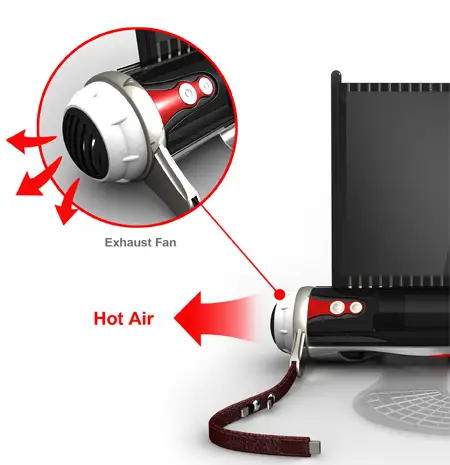
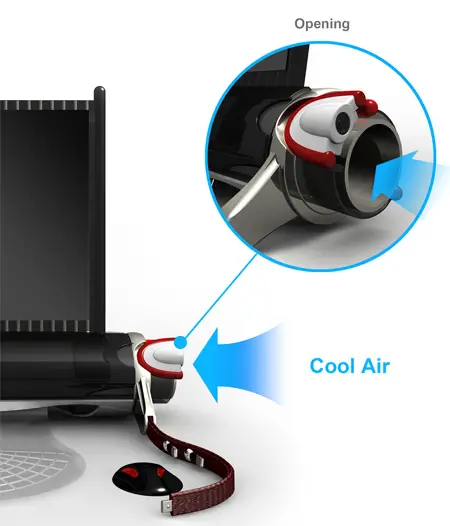
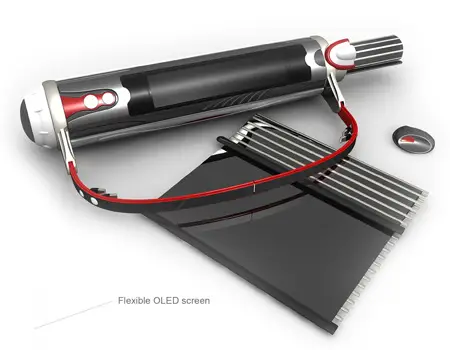
D-Roll Laptop:
Sunday, November 8, 2009
Online servo database with user reviews
Online servo database with user reviews


A reader just sent me a link to servodatabase.com, which lists RC servo specifications and provides user reviews, a comparison engine, and various forms of sorting. Looks like a very good resource.


A reader just sent me a link to servodatabase.com, which lists RC servo specifications and provides user reviews, a comparison engine, and various forms of sorting. Looks like a very good resource.
Robots Powered Remotely By Lasers Will One Day Climb To Space
Robots Powered Remotely By Lasers Will Climb To Space:
 Gravity sucks. Gravity especially sucks when you’re trying to get into orbit. It sucks because vehicles like the space shuttle expend most of their energy just hauling along the fuel they need to make it into orbit, instead of something useful like more payload or myself. Like, I’m pretty sure I read somewhere that the space shuttle could lift off with no trouble using just its main engines; the boosters are needed primarily to lift the external fuel tank. This is why Virgin Galactic launched SpaceShipOne from an airplane, why NASA is investigating launching satellites directly from high altitude balloons, and why an elevator to space that’s powered from the ground would be the best thing for spaceflight since Ham.
Gravity sucks. Gravity especially sucks when you’re trying to get into orbit. It sucks because vehicles like the space shuttle expend most of their energy just hauling along the fuel they need to make it into orbit, instead of something useful like more payload or myself. Like, I’m pretty sure I read somewhere that the space shuttle could lift off with no trouble using just its main engines; the boosters are needed primarily to lift the external fuel tank. This is why Virgin Galactic launched SpaceShipOne from an airplane, why NASA is investigating launching satellites directly from high altitude balloons, and why an elevator to space that’s powered from the ground would be the best thing for spaceflight since Ham.Freely admitting that they’re not up to the task of designing such an elevator (either the car or the tether, which has to be about 62,000 miles long), NASA has opened it up to everybody as part of their Centennial Challenges. This week, a bunch of different robots competed to climb a kilometer into the sky using only power transmitted from the ground by lasers so powerful that they have to turn them off when satellites fly overhead. The winner zipped up the tether at nearly 4 meters per second netting a prize of almost $1 million, which is pretty good, even though at that speed, it would take just under a year to make it into geosynchronous orbit. The point is, these robots don’t have to lift any fuel: with the engine on the ground, it’s all payload.
Friday, November 6, 2009
Space Hotel Reportedly On Track for 2012 Opening, Already Has Paying Guests
 Space Hotel Reportedly On Track for 2012 Opening:
Space Hotel Reportedly On Track for 2012 Opening:A company aiming to open the first space hotel already has 43 paying customers at $4.4 million a pop
Anyone with a cool $4 million and change might consider doing what 43 other people have done, and sign up for an orbital space vacation in 2012 with Galactic Suite Space Resort. The Barcelona-based company plans to open the first space hotel if all goes according to plan.
Space customers would spend three nights in their orbital pod room, where they could crawl around like Spiderman (or Venom) in Velcro suits. 'Reuters' reports that guests would also enjoy an eight-week training course set on a tropical island.
The price tag falls far below the $35 million paid by first repeat space tourist Charles Simonyi, or the same higher amount required to book an orbital vacation aboard a surplus Soviet-era military spacecraft.
http://www.galacticsuite.com/
Satellites used for farming in good soil:
Satellites used for farming in good soil:
There was a time when a farmer simply tasted a clump of dirt to tell the fecundity of the soil. Now, a wide range of chemical analysis help instruct farmers on the optimal mix of fertilizer, pesticide and water. However, tests on soil samples are expensive and time consuming, and few farmers can afford to waste either time or money. And that's where the satellite imaging comes in.
 The electromagnetic radiation reflected by farmland contains within it vast amounts of information about the chemical competition of the soil. By measuring the reflected radiation of entire fields, satellites now provide a cheaper, and more comprehensive, alternative to the testing of soil samples.
The electromagnetic radiation reflected by farmland contains within it vast amounts of information about the chemical competition of the soil. By measuring the reflected radiation of entire fields, satellites now provide a cheaper, and more comprehensive, alternative to the testing of soil samples.
The service costs about $15 per 2.5 acres for a couple of scans a year, and the information imparted by the satellite scans has already proven to increase crop yield by as much as 10 percent.
In France, a grain-grower's co-op has even automated the process, linking GPS carrying farm equipment to the satellites. The farm vehicles carry about 50 different mixes of fertilizer formula, each one customized to particular soil characteristics. The satellite data links to the GPS system, and the vehicles automatically distribute the optimal fertilizer mix for the different soil quality regions identified by the satellites.
Beyond the industrialized world, non-profits and government organizations have already booked satellite overflights of the world's most impoverished farmlands in Africa. The readings from the satellites provide cheap and easy recommendations for increasing yield in a continent continually plagued by drought and famine. Farmer's Almanac, meet the space age.
There was a time when a farmer simply tasted a clump of dirt to tell the fecundity of the soil. Now, a wide range of chemical analysis help instruct farmers on the optimal mix of fertilizer, pesticide and water. However, tests on soil samples are expensive and time consuming, and few farmers can afford to waste either time or money. And that's where the satellite imaging comes in.
 The electromagnetic radiation reflected by farmland contains within it vast amounts of information about the chemical competition of the soil. By measuring the reflected radiation of entire fields, satellites now provide a cheaper, and more comprehensive, alternative to the testing of soil samples.
The electromagnetic radiation reflected by farmland contains within it vast amounts of information about the chemical competition of the soil. By measuring the reflected radiation of entire fields, satellites now provide a cheaper, and more comprehensive, alternative to the testing of soil samples. The service costs about $15 per 2.5 acres for a couple of scans a year, and the information imparted by the satellite scans has already proven to increase crop yield by as much as 10 percent.
In France, a grain-grower's co-op has even automated the process, linking GPS carrying farm equipment to the satellites. The farm vehicles carry about 50 different mixes of fertilizer formula, each one customized to particular soil characteristics. The satellite data links to the GPS system, and the vehicles automatically distribute the optimal fertilizer mix for the different soil quality regions identified by the satellites.
Beyond the industrialized world, non-profits and government organizations have already booked satellite overflights of the world's most impoverished farmlands in Africa. The readings from the satellites provide cheap and easy recommendations for increasing yield in a continent continually plagued by drought and famine. Farmer's Almanac, meet the space age.
Wednesday, November 4, 2009
Military Robotics
Military Robotics
 How are robots changing war? Peter Singer talks about how robots are changing how we fight wars and how robots will change the way we fight war in the future. How does using robots in war change public perception of war? With thousands of robots already in the air and on ground of warzones, what part do they currently play in war and how will they change how we think and fight wars in the future?
How are robots changing war? Peter Singer talks about how robots are changing how we fight wars and how robots will change the way we fight war in the future. How does using robots in war change public perception of war? With thousands of robots already in the air and on ground of warzones, what part do they currently play in war and how will they change how we think and fight wars in the future?
 How are robots changing war? Peter Singer talks about how robots are changing how we fight wars and how robots will change the way we fight war in the future. How does using robots in war change public perception of war? With thousands of robots already in the air and on ground of warzones, what part do they currently play in war and how will they change how we think and fight wars in the future?
How are robots changing war? Peter Singer talks about how robots are changing how we fight wars and how robots will change the way we fight war in the future. How does using robots in war change public perception of war? With thousands of robots already in the air and on ground of warzones, what part do they currently play in war and how will they change how we think and fight wars in the future?Ericsson's Spider PC Concept
Ericsson's Spider PC Concept:
Ericsson has shown off an interesting PC design at the Taiwan Broadband Show, the Ericsson Spider PC Concept.
The Spider PC concept is Ericsson’s vision for portable computers of the future, it uses a pico projector to project a screen onto the wall, and a laser projector to project a keyboard onto your desk.



Ericsson imagine that the device will have all the features of a laptop, like WiFi, and a built in battery, it certainly looks like an interesting idea, check out the video of it in action below.
Make a USB charger from 9Volt battry
Make a 9V battry USB charger:-
Battery powered USB chargers are pretty cheap at Amazon and other places, but as with everything else it's always more fun to make your own. The basic concept of a USB charger is actually pretty simple, and you don't really need more than a couple of very cheap components to make one yourself.
Concept and parts
The concept is simple; USB power is 5V. What else is 5V? No batteries. Sometimes you find chargers that use 4 AA/AAA batteries as this is 4.8V (if rechargable, 1.2V x 4) or 6V (if disposable, 1.5V x 4) but to have a charger that produces exactly 5V you need a voltage regulator. Such a regulator is the 7805 model you can get at Radio Shack for $1.59. This will take a voltage between 7.5V and 20V (according to Google research) and turn it into a steady 5V. Turn this into a charger, and there you go.
On top of this you also need a suitable power source (9V battery in my case), some wires (and a battery connector in my case) and a connector to connect to the device you want to charge- like a female USB port you can salvage off old computers etc.
The build
The assembly process is so simple it's almost redundant to describe it. Wire the setup like in the diagram and solder it stuck and you're basically done. With a 7805 regulator with a TO-220 type case like the one linked to above, the diagram shows the heatsink pointing away from you. The positive lead from the battery goes to the regulators left leg, and the regulated 5V goes from its right leg to the far left pin of the female USB port as it is when you're holding the female port pointing towards you with the pins pointing down from the plastic part they're stuck to. The ground wire goes from the battery to the middle leg of the regulator and then continues to the far right pin of the female USB port. Just look at the diagram and you'll see what I mean.
You might want to use a hot glue gun or some sort of casing to make it stick together. I wanted a very small easy to carry solution so I made it all into a single small adapter, but you might want to use multiple batteries (5x D batteries in a series would give you a lot of juice, for example) or another design for yours.
Not all devices will be able to charge from such a setup due to limitations in place by the manufacturers. Since you're making this from scratch, you might actually be able to make on that works if you know the criteria for you device to charge (such as having the two middle USB pins connected).
Concept and parts
The concept is simple; USB power is 5V. What else is 5V? No batteries. Sometimes you find chargers that use 4 AA/AAA batteries as this is 4.8V (if rechargable, 1.2V x 4) or 6V (if disposable, 1.5V x 4) but to have a charger that produces exactly 5V you need a voltage regulator. Such a regulator is the 7805 model you can get at Radio Shack for $1.59. This will take a voltage between 7.5V and 20V (according to Google research) and turn it into a steady 5V. Turn this into a charger, and there you go.
On top of this you also need a suitable power source (9V battery in my case), some wires (and a battery connector in my case) and a connector to connect to the device you want to charge- like a female USB port you can salvage off old computers etc.
The build
The assembly process is so simple it's almost redundant to describe it. Wire the setup like in the diagram and solder it stuck and you're basically done. With a 7805 regulator with a TO-220 type case like the one linked to above, the diagram shows the heatsink pointing away from you. The positive lead from the battery goes to the regulators left leg, and the regulated 5V goes from its right leg to the far left pin of the female USB port as it is when you're holding the female port pointing towards you with the pins pointing down from the plastic part they're stuck to. The ground wire goes from the battery to the middle leg of the regulator and then continues to the far right pin of the female USB port. Just look at the diagram and you'll see what I mean.
You might want to use a hot glue gun or some sort of casing to make it stick together. I wanted a very small easy to carry solution so I made it all into a single small adapter, but you might want to use multiple batteries (5x D batteries in a series would give you a lot of juice, for example) or another design for yours.
Not all devices will be able to charge from such a setup due to limitations in place by the manufacturers. Since you're making this from scratch, you might actually be able to make on that works if you know the criteria for you device to charge (such as having the two middle USB pins connected).


